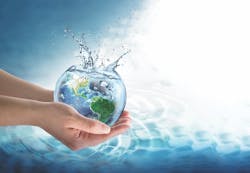How to Conserve Water Efficiently
About the author:
Margaret Hunter is engineering manager for American Water. Hunter can be reached at [email protected].
Think about this: only 3% of the water on Earth is freshwater and, of that, only a mere 0.5% is available for everything from drinking water to growing crops and manufacturing to hygiene.
The limited supply of nature’s most precious resource is not stopping the average American from taking advantage of the global water supply. They use anywhere between 80 to 100 gallons of water per day, which adds up to roughly 29,000 gallons per American per year. In addition to high usage, other challenges like the increasing human population, climate variability and the current COVID-19 public health emergency are also posing a threat to the global water supply.
Water and wastewater professionals play a key role in helping protect this valuable resource, starting with increased efforts towards water efficiency and conservation. However, how exactly can utilities go about making a more concerted effort and commitment to water efficiency? Consider these four strategies to take conservation messaging to the next level.
1. Understand the consequences if the issues go unrecognized.
The first step in being a true advocate for any cause is to fully grasp the issues at hand. When it comes to water efficiency, this understanding is rooted in being aware of the risks that might occur should this global problem not be addressed. For one, a lack of focus on water efficiency could lead to a lack of water, which can have consequences like rising costs, reduced food supply, health hazards and political unrest.
Not to mention, a shortfall in the global water supply has dire environmental impacts, such as increased use of energy needed to power homes, businesses and communities, in turn leading to more pollution and use of fuel and electricity resources.
On a more positive note, when individuals collectively focus their attention on water efficiency, the possibilities are endless. In addition to addressing costs and environmental challenges, increased water supply could help build safer, healthier and more viable communities. Hospitals, health clubs and gyms as well as restaurants all require large amounts of water to provide their services and operate effectively. More efficient water usage means those services can continue to operate without risking health or the possibility of shutting down.
2. Demonstrate commitment & leadership.
Water and wastewater professionals also need to practice a steadfast commitment to water efficiency throughout existing facilities. Start by evaluating all water use practices and evaluate the efficiency of treatment systems as well. Put an emphasis on accurately metering, monitoring and tracking all water consumption data at least once a month to identify any consumption or rate increases that might indicate an increase in water usage.
Finally, according to the American Water Works Association (AWWA), utilities should use comprehensive, integrated resources to make full use of conserved water in water supply planning, and should participate in regional coordination and integration efforts.
Conserved water should be viewed as a source of water that provides multiple benefits such as growth, environmental flows, and expanded economic uses, and these should be equal in importance to the utilities’ primary water source, from a utility and rate setting perspective. In many cases, water efficiency is the least costly option for a new source of supply. Utilities should also consider working with other agencies to adopt and implement efficient water use practices and land use policies.
3. Make water efficiency a key element of customer education.
For any organization implementing a water efficiency strategy, there is significant power in educating customers. In fact, research has shown that public education programs can help achieve the goals of a water utility’s water efficiency strategy and even increase customer participation in any programs that are being implemented. Customers will also make smarter and more informed decisions about their own water usage if they are more educated.
What does effective customer education look like? Consider creating various toolkits for customers with resources that discuss the importance of water efficiency and conservation, how they can make small changes to conserve water in their daily lives, and what your organization is doing to address these issues. Develop physical or online reminders of the value of water and the issues at stake. Include access to educational programs or webinars or the contact information of someone in your organization, if a customer is interested in learning more.
While customer education is certainly important, do not limit efforts to only those within your purview. Rather, support greater education and public awareness efforts by expanding access to educational materials to the greater public and supporting continued research in water conservation and efficient water use practices.
4. Help homeowners do their part with new technologies.
Approximately 17 gallons of water are lost every day due to leaks in homes. In annual numbers, that amount of water wasted is astronomical. This makes it much more difficult for utilities to keep up with treatment of an increasing number of leaks, and it causes greater risks of wasting this most precious resource. With technology advancing so quickly, certain measures can be put in place to proactively address some of these challenges before they even arise.
The time to ramp-up water efficiency efforts is now. According to the U.S. EPA, at least 40 states in the U.S. anticipate water shortages by 2024, and with the country’s population rapidly multiplying and our use of water increasing, the need for efficiency has never been more critical.
Utilities have a tremendous opportunity to lead by example to protect and preserve our water supply so it will be available for generations to come.
